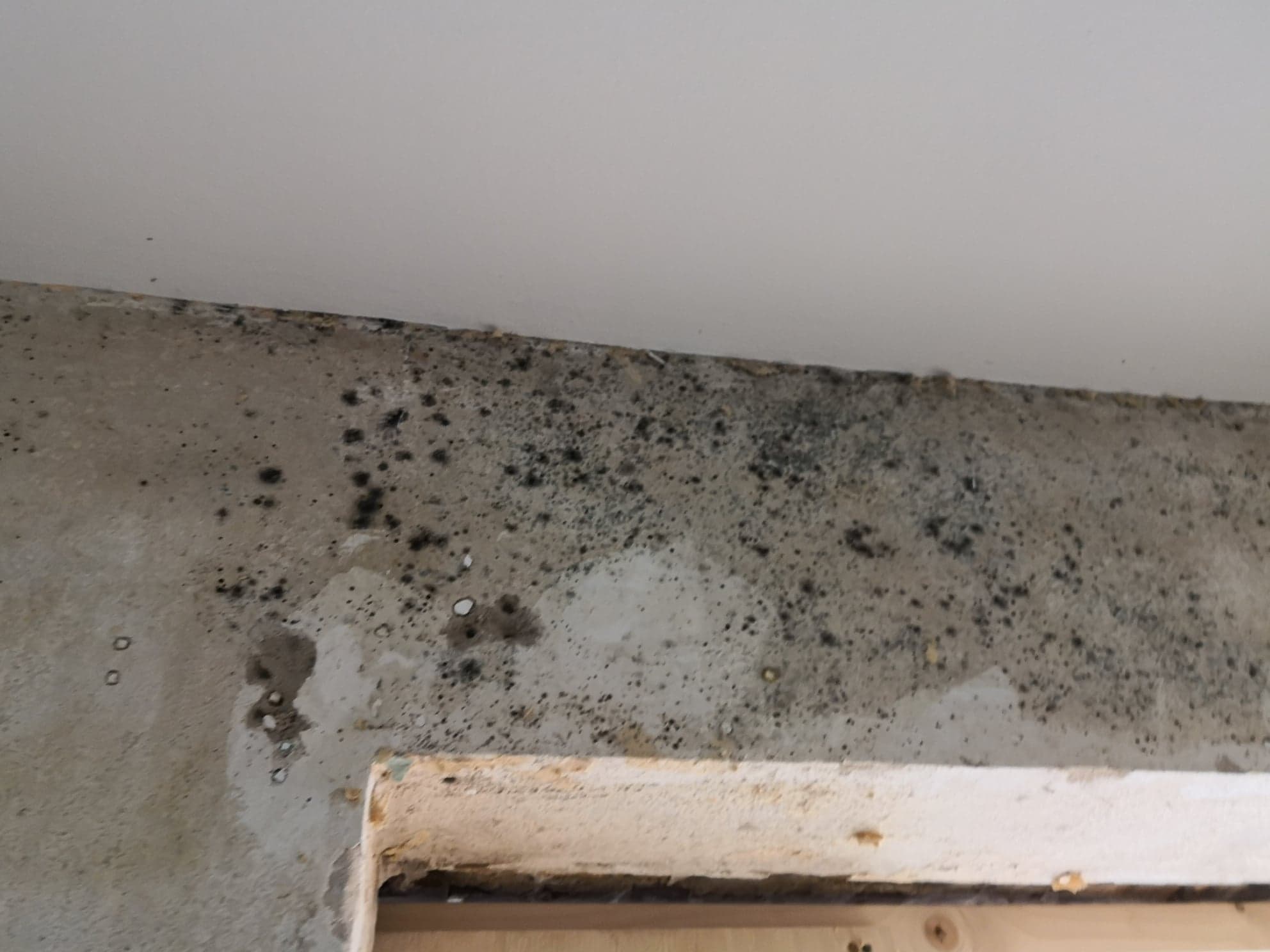Skimmelsvamp
– et problem i danske bygninger?
I disse år er der øget fokus på skimmelsvamp i boligen. På trods af flere medicinske, biologiske og byggetekniske undersøgelser, er der stadig uafklarede forhold omkring hvordan skimmelsvamp virker på indeklimaet. Der mangler klare grænseværdier for hvornår skimmelsvamp er uacceptabel i boligen. Her ses bort fra mennesker som reelt er overfølsomme overfor skimmelsvamp. Det kræver indgående speciallægefaglig indsigt at kunne vurdere disse forhold og så længe der ikke er enighed indenfor den lægefaglige ekspertise, er det overordentligt vanskeligt for “os andre” at vurdere de sundhedsmæssige aspekter. Blandt rådgiverne er der ligeledes uenighed om hvordan bygningen skal undersøges, samt hvilke analysemetoder der er bedst at anvende ved angreb af skimelsvamp. Det er forståeligt at forbrugeren har svært ved at forholde sig til fup eller fakta.
Denne artikel beskriver problemerne omkring skimmelsvamp ud fra en biologisk og byggeteknisk vinkel. Der henvises i øvrigt til BYG-ERFA fondens seneste erfaringsblad om skimmelsvamp.
I det følgende er der en gennemgang af:
- Hvad er skimmelsvamp?
- Vækstbetingelser
- Skimmelsvamp og indeklima
- Bekæmpelse af skimmelsvamp
- Forebyggelse mod skimmelsvamp
Hvad er skimmelsvamp?
Skimmelsvamp stammer fra naturen og findes overalt. Ligesom planterne og dyrene, har også skimmelsvampe (sammen med andre svampetyper) deres egen biologiske gruppe. Skimmelsvamp er primitive svampe, der ikke er i stand til at danne frugtlegemer.
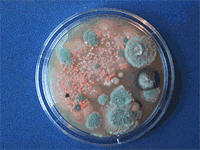 | 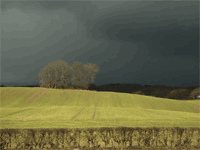 | ||
| Skimmelsvamp på kontaktaftryk | Skimmelsvamp stammer fra naturen |
Under gunstige betingelser vil skimmelsvampesporerne spire, vokse ud som hyfer (celletråd) og dermed danne et mycelium (væv af svampens celletråde) man kan se typisk som sorte, hvidlige, brunlige eller blågrønne kolonier på bygningsmaterialet, madvarer o.lign. I myceliet dannes millionvis af nye sporer som spredes med vinden. I vinterhalvåret, hvor naturen ligger i dvale, er koncentrationen af skimmelsporer i udeluften meget lav. I løbet af foråret vækkes naturen af dvalen og man kan igen registrere skimmelsporer i udeluften. I sensommeren ses de højeste koncentrationer af skimmelsvampesporer, hvor der kan forekomme mange tusinde sporer/m3 udeluft.
Hvorfor forekommer skimmelsvamp i bygninger? – Vækstbetingelser
Skimmelsporerne bringes ind i boligerne med udeluften og såfremt de rette betingelser er til stede i boligen vil sporene spire og en skimmelvækst er startet. En forudsætning for skimmelvækst er, at der er fugt tilstede. Fugt kan opstå på mange måder. Typisk skyldes fugt dårlige boligvaner kondens som følge af kuldebroer, utætte vandinstallationer, utæt klimaskærm, oversvømmelse og brandslukningsvand. Endelig kan kombinationer naturligvis forekomme. Når den relative fugtighed i boligen i længere tid overstiger 75-85% vil der med sikkerhed opstå skimmelvækst. Også temperaturen har betydning. De fleste skimmelsvampe vokser bedst ved 15-28 graders C. Nogle typer kan vokse ved lave temperaturer (5-10 graders C) mens andre kan vokse ved høje temperaturer (50 graders C).
 | 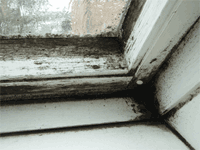 | ||
| Skimmelvækst på etagebjælke efter vandskade | Sortskimmel på tagvindue |
Hvor forekommer skimmelsvamp i bygningen?
Skimmelvækst kan forekomme overalt i bygningen blot de rette betingelser er tilstede. Byggematerialer bestående af organiske materialer så som gipsplader, tapet, træ, finer mv. er særligt udsatte, men skimmelsvamp kan også trives på våd beton og murværk. Jordslåethed, som skyldes sortpigmenterede skimmelsvamp, ses typisk ved lavere temperaturer på fx. kuldebroer, vindueslysninger, koldtvandsrør mv. Mangelfuld rengøring i hjemmet vil desuden kunne give grobund for skimmelvækst. Husstøvet består af organiske materialer som skimmelsvampene kan leve af.
Er skimmelsvamp skadelig for indeklimaet?
Skimmelsvamp består af og indeholder bestanddele som under visse betingelser kan være generende i indeklimaet. Derudover vil skimmelsvamp i aktiv vækst kunne afgive flygtige stoffer (VOC’er) til indeluften og afgive svampegifte (mycotoxiner) til det materiale de vokser på. Nogle skimmelsvampearter kan afgive stoffer som giver en karakteristisk stikkende og ubehagelig muglugt, der kendes fra fugtige sommerhuse, kældre, hengemt tøj under fugtige forhold osv.
Hvis skimmelsvamp optræder i større omfang i boligen i længere tid vil de kunne give indeklimagener som slimhindeirritationer i øjne, næse og svælg. Symptomer som træthed, hovedpine og koncentrationsbesvær kan i visse tilfælde også tilskrives skimmelsvampevækst i boligen. Disse symptomer kan dog også forårsages af andre forhold som fx. astma, psykosociale forhold (dårlige arbejdsforhold, mobning, konflikter mv.)
Det er næppe sandsynligt at hverken mycotoxiner eller voc’er vil kunne afgives i så store koncentrationer i en bolig, at de vil kunne forårsage indeklimaproblemer. Derimod er det kendt at skimmelsvampesporer og fragmenter (partikler) fra skimmelsvamp kan give gener for mennesker der er overfølsomme (allergi) overfor skimmelsvamp. Skimmelsporer og hyfer indeholder både fremmede proteiner og kulhydrater (glukaner) som kan virke allergifremkaldende overfor overfølsomme mennesker. Det vil derfor være vanskeligt eller umuligt for disse mennesker at opholde sig i boliger med skimmelsvamp. Vil du vide mere om disse forhold kan du hente Sundhedsstyrelsens pjece om skimmelsvamp.
Hvordan skal man forholde sig ?
Vi skal ikke acceptere vækst af skimmelsvamp i boligen ud over hvad der er normalt. Har en lejer mistanke om at der kan være skimmelvækst, bør man som udlejer altid tage problemet alvorligt. Start med at undersøge om der er et problem der kræver en indsats. Ofte vil der være tale om et mindre problem der kan løses ved simpel afrensning. I andre tilfælde vil det være hensigtsmæssigt at søge råd hos et af de rådgivningsfirmaer der har erfaring i at undersøge en bygning for skimmelsvamp.
Betragt boligen som et sted med både inde- og udezoner. Skimmelsvamp i en udezone som fx. et loft eller en krybekælder betyder mindre end hvis skimmelsvamp findes i en indezone som boligens opholdsrum, hvor man skal tilbringe mange timer i løbet af døgnets 24 timer.
Hvordan undersøger man for skimmelsvamp?
En undersøgelse for skimmelsvampeangreb i bygningen bør altid være destruktiv. Kun derved kan man i tilstrækkelig grad få afdækket skjulte forekomster af skimmelsvamp. Særligt i fugtige bygninger skal der udvises agtpågivenhed i de skjulte konstruktionsdele hvor fugt har svært ved at slippe væk og derfor giver grobund for skimmelvækst. Efter vandskader skal man være ekstra påpasselig med at få undersøgt hulrum i skillevægge, gulve mv. Glemmes udtørringen sådanne steder vil der ofte opstå skimmelsvampevækst efter bare 1-2 uger.
Der findes adskillige analysemetoder til påvisning af skimmelsvamp. Ingen af metoderne kan sammenlignes direkte. Det er derfor meget vigtigt, at den der udfører analyserne kender til den valgte metodes både svagheder og styrker. I det følgende skal kort gives eksempler på metoder til påvisning af skimmelsvamp i boligen. Der er tale om væsentlige prisforskelle på de nævnte analysemetoder.
 | 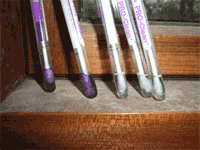 | ||
| Skimmelsvamp på ydervæg – Kuldebro | ProClean test |
Kontaktaftryk – er en lille plastikskål med et dyrkningsmedium (som regel tomatjuicegel, kaldet V8) som kan aftrykkes på en overflade, hvorved skimmelvækst, sporer mv. overføres til dyrkningsmediet og derefter hjembringes til dyrkning på laboratoriet i ca. 7 dage. De fremkomne skimmelsvampekolonier kan herefter tælles og navngives
Følgende kriterier anvendes til at beskrive omfanget af skimmelvækst:
- Ringe vækst < 10 kolonier
- 10 < moderat vækst < 50
- Massiv vækst > 50 kolonier
Luftanalyser – er analyser der opsamles direkte fra luften ved hjælp af specielt opsamlingsudstyr (slit-samplere) eller på agarskåle med dyrkningsmedium. Luftanalyserne kan give undersøgeren et billede af i hvor høj grad indeluften er forurenet af skimmelsvamp og i givet fald om disse stammer fra boligen eller er tilført fra udeluften (naturen).
Materialeprøver – herunder tape-aftryk – er en analysemetode, hvor man udtager fx. tapetprøver eller tapeaftryk fra overfladen og derefter under et mikroskop kan se hvad og hvor meget skimmelsvampevækst der sidder på den undersøgte overflade.
De følgende metoder er alle såkaldte hurtigmetoder, der udføres ved svabring af overfladen med en vatpind og efterfølgende kemisk analyse:
Mycometer – analyserer på et enzym som er karakteristisk for skimmelsvamp. Opererer med 3 katagorier, A: < 25, B: > 25 og < 450 og C: > 450.
ATP – analyserer for det kemiske stof adenosintriphosfat som findes i alle levende celler. ATP-tal under 100-200 (ikke endeligt fastsat) vil sædvanligvis kunne godkendes.
ProClean – er en proteintest der ikke kræver noget instrument, men giver en tydelig violet farvereaktion hvis der er proteiner tilstede.
Udbedring efter angreb af skimmelsvamp
Det er vigtigt at årsagen til skimmelsvampevæksten findes og fjernes. Om nødvendigt skal der sættes ind med en korrekt udtørring. Det vil ofte være klogt at entrere med et professionelt udtørringsfirma der er i besiddelse af både erfaring og det korrekte udstyr til den pågældende opgave. Når en skimmelsvamperenovering skal igangsættes er det vigtigt at afsætte den fornødne tid til både planlægning af opgavens forløb og information af alle involverede. Herefter kan renoveringen gennemføres i ro og mag under behørigt hensyn til kvalitetskontrol og sikkerhed omkring udførelsen.
Valg af metode
Inden igangsætning af en skimmelsvampeudbedring skal der tages beslutning om de skimmelsvampeangrebne materialer skal kasseres eller de kan rengøres og genbruges. Det vil normalt bero på en økonomisk vurdering.
Som udgangspunkt skal skimmelsvampevæksten fjernes og ikke blot dræbes eller udtørres. De døde skimmelsporer og partikler fra skimmelsvampene vil indeholde fremmede proteiner og kulhydrater som vil være allergifremkaldende for overfølsomme personer.
Udbedringsmetoder
Ved udbedring af skimmelsvampeangreb kan anvendes både mekaniske og kemiske metoder og ofte udføres de i kombinationer. Den valgte metode vil altid bero på den konkrete skade, bygningsforhold, bygningsmaterialer osv. Mekaniske metoder omfatter teknikker som slipning, afhøvlning, fræsning, damprensning (tørdamp), højtryksrensning med hed vand, isafrensning m.fl. Ved større opgaver er det hensigtsmæssigt at den valgte metode afprøves på et lille areal for at undgå fordyrende genbehandlinger.
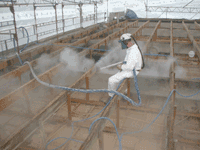 | 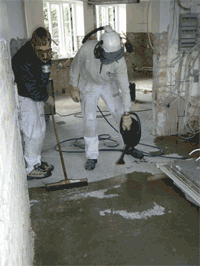 | ||
| Isafrensning af tagspær | ProtoxBiox behandling af |
Ved en desinfektion uskadeliggøres og fjernes skimmelvæksten. Til desinfektionen anvendes ProtoxHysan og/eller ProtoxBiox. Ingen af de 2 nævnte midler efterlader kemiske rester der efterfølgende kan have nogen negativ indflydelse på indeklimaet.
I visse tilfælde kan det være nødvendigt efter en desinfektion at foretage en forebyggelse for at undgå at skimmelsvampevæksten skal genopstå. Det vil typisk være på en kuldebro, fugtigt fundamentet, undertag af træfiner mv. I disse tilfælde anvendes midlet Protoxskimmel der indeholder fungicid. En afgasningsundersøgelse, udført af Eurofins Miljø A/S, viser, at der ikke kan konstateres afgasninger fra produktet.
Hvordan anvendes ProtoxHysan, ProtoxBiox og Protoxskimmel?
Der henvises til teknisk mærkeblad og produktbeskrivelserne for de enkelte produkter:
- ProtoxHysan – Produktbeskrivelse, anvendelse og indeklimarapport.
- ProtoxBiox – Produktbeskrivelse, anvendelse og BST-rapport.
- Protoxskimmel – Produktbeskrivelse, anvendelse og indeklimarapport.
Hvordan forebygges mod skimmelsvamp?
- Gå huset/boligen efter for indtrængende fugt og sørg for at udbedre alle fugtskader – check tagrender, kloakker, brønde, vinduer, døre, tagbelægning, skotrender mv.
- Undlad at tørre tøj i boligen – heller ikke på badeværelset, hæng fugtige håndklæder udenfor på tøjsnoren efter badning.
- Brug emhætten ved madlavning, kontroller at udsugning virker som den skal.
- Udluft hyppigt men kortvarigt, så nedkøling af overflader undgås.
- Skru op for varmen.
- Er der dug på termoruderne er det tegn på for høj fugtighed i indeluften. Anskaf evt. et hygrometer og kontroller at fugten aldrig overstiger 60% relativ fugtighed.
